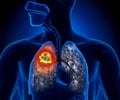New papers on an exhaled-breath test for lung cancer have been published, highlighting advancements in early detection methods.

Exhaled breath condensate contains extracellular vesicles (EVs) that carry miRNA cargos of lung tissue origin that can be selectively purified and analyzed
Go to source). Two papers published by CDI (Career Development Institute) Associate Member Olivier Loudig, Ph.D., and colleagues show that they have successfully collected, separated, and profiled lung biomarkers from human breath, and also developed animal models to expand their analyses and potentially identify key markers for early and non-invasive detection of metastatic lung tumors.
‘Some people with #lungcancer may have an immune response that targets their own tumor cells. #lungcancerdiagnosis #breathtest’





Significant work remains to be done to identify a range of the biomarkers and prove that its accuracy can be clinically relevant for human patients, but the two publications have established the scientific roadmap as the CDI scientists continue their work toward that goal. “This innovative non-invasive approach is aimed at establishing a new method to lower the threshold for earlier than ever before detection of this horrible disease,” said Loudig.
New Study Brings Hope for Earlier Lung Cancer Diagnosis
“This innovative technology developed by Olivier Loudig offers promise and hope to patients who all too often receive a diagnosis too late for effective intervention,” said David Perlin, Ph.D., the chief scientific officer and executive vice president of the CDI. “This is what the CDI is all about: inspire science innovation to address unmet medical needs.”Dr. Loudig’s work focuses on the capture and identification of nanoparticles known as extracellular vesicles (EVs), which are released by virtually all cells into the extracellular space such as blood, serum, and other biofluids. Cancer cells especially release a greater number of nanoparticles, which Dr. Loudig has been targeting for earlier-than-ever disease detection and diagnostics. His laboratory at the CDI has developed research programs for biomarker discovery and early detection of lung, prostate, cervical, and bladder cancers using liquid biopsies.
To do so, the group of Dr. Loudig developed a technology called Extracellular Vesicle Capture by AnTibody of CHoice and Enzymatic Release (EV-CATCHER) for selective isolation of cell-specific nanoparticles from biofluids, and is using next-generation sequencing profiles of small-RNAs contained in these nanoparticles for non-invasive identification of lesions and tumors that may be developing in the body. Dr. Loudig’s science and EV-CATCHER technology are the foundation of Hackensack Meridian Health’s first spin-off company, EValuate Diagnostics, founded early this year.
Advertisement
In their latest publication, which appears in the Journal of Extracellular Vesicles, a leading high-impact journal, the CDI team assessed five types of airway samples from 69 subjects and determined that exhaled EVs contain microRNA expression profiles consistent with of those obtained from deeper lung samples via more invasive procedures like bronchoalveolar lavages (BAL).
Advertisement
“Our analyses confirm the utility of our customizable EV‐CATCHER assay for the selective purification of exhaled EVs harboring surface proteins of terminal bronchiole and alveoli lung tissue origin from (exhaled breath condensate),” they write.
Their earlier mouse model study of exhaled breath condensates published in March in the journal Extracellular Vesicles and Circulating Nucleic Acids shows they could detect human-derived tumor cell microRNAs using EV-CATCHER to “catch” human exhaled lung tumor EVs from exhaled breath within 1-2 weeks following the injection of human cancer cells. Though the selection of biomarkers needs to be refined and finalized, the scientists conclude that there is promise for a diagnostic of lung diseases - most notably lung cancer.
“We envision that expanding our approach to study human primary and other secondary lung cancers, in adequately-powered animal studies, has the potential to identify relevant exhaled human EV biomarkers,” they write. “Furthermore, since EV-CATCHER can easily be customized to target surface markers of specific EV subpopulations, we foresee that using it to separate lung tumor cell-derived exhaled EVs from immune and innate cell-derived EVs may help further improve the selection of exhaled tumor EVs for the fine-tuned detection of different types of lung cancer.”
“The work of Olivier Loudig is platform technology with exceptional promise,” said Ihor Sawczuk, M.D., FACS, Hackensack Meridian Health’s president of Academics, Research and Innovation, founding chair of the Hackensack Meridian Health Research Institute, and associate dean of Clinical Integration and professor and chair emeritus of Urology at the Hackensack Meridian School of Medicine. “We are glad to support his ongoing investigations into developing innovative solutions to test for disease like cancer.”
Reference:
- Exhaled breath condensate contains extracellular vesicles (EVs) that carry miRNA cargos of lung tissue origin that can be selectively purified and analyzed - (https://isevjournals.onlinelibrary.wiley.com/doi/10.1002/jev2.12440















